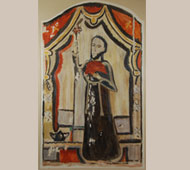Adobe Gallery Blog
Subject: Original Painting of a Panel from a Church Altar Screen
 The prosperity of the 1920s ended with the economic catastrophe known as the Great Depression. By 1933 industrial production had fallen, thousands of banks were closed, and millions of Americans were jobless. President Franklin D. Roosevelt's "New Deal" aimed at promoting economic recovery and putting Americans back to work through Federal jobs programs for the unemployed. Establishing the foundation of the modern welfare state while preserving the capitalist system, the New Deal experimented with unprecedented activism in an attempt to relieve the social and economic dislocation experienced by much of the nation. Federal programs extended not only into American business, agriculture, labor, and the arts, but into people's daily lives. Despite a mixed legacy with respect to recovery and reform, the political response under Roosevelt proved that economic crisis did not require Americans to abandon democracy.
The prosperity of the 1920s ended with the economic catastrophe known as the Great Depression. By 1933 industrial production had fallen, thousands of banks were closed, and millions of Americans were jobless. President Franklin D. Roosevelt's "New Deal" aimed at promoting economic recovery and putting Americans back to work through Federal jobs programs for the unemployed. Establishing the foundation of the modern welfare state while preserving the capitalist system, the New Deal experimented with unprecedented activism in an attempt to relieve the social and economic dislocation experienced by much of the nation. Federal programs extended not only into American business, agriculture, labor, and the arts, but into people's daily lives. Despite a mixed legacy with respect to recovery and reform, the political response under Roosevelt proved that economic crisis did not require Americans to abandon democracy.
New Mexico was among the poorest states in the Union in the 1920s and it went from bad to worse with the onset of the Depression. The New Deal programs administered throughout the country were especially needed in New Mexico and particularly in rural villages. Perhaps the best known of the back-to-work projects was New Mexico's various arts and crafts projects. The most ambitious of these in New Mexico was the Federal Art Project (FAP) under the direction of Russell Vernon Hunter. Just one year after the start of the program, some 40,000 WPA artists and other cultural workers were employed in projects throughout the United States.
In New Mexico, Hunter supported regional and cultural artistic expression and was lucky to have had both native and established East Coast artists. The various art projects had at their core in New Mexico altruistic efforts to record and preserve traditional native, be it Native American or Hispano, cultural production. Many murals were painted in public buildings in New Mexico and many church altars were copied as a means of preserving them for the future.
This painting of a panel from a New Mexico church altar is typical of some of the activities promoted and was quite likely made by a New Mexican by the name of Jorge Sanchez of Albuquerque who is believed to have worked under the sponsorship of artist Cady Wells. What appears to be damage on the painting is actually the true representation of the damaged altar panel that Sanchez copied. It appears that this is a watercolor, on paper, fixed to artist board. It unfortunately was not signed by the artist.
Condition: appears to be in original condition.
Provenance: from the collection of Katherine H. Rust of Albuquerque
References: The above information on the WPA in New Mexico is based on a published article by the New Mexico Office of the State Historian. The attribution of the work to Jorge Sanchez was from consultation with Santa Fe resident Elizabeth McGorty and gallery owner Nat Owens.
Subject: Original Painting of a Panel from a Church Altar Screen
Artist: Jorge Sanchez - Attribution
Category: Paintings
Origin: European-American Artists
Medium: watercolor on paper
Size: 39-1/2" x 24-1/2" image; 44-1/4" x 29-3/4" framed
Item # C3224AP

